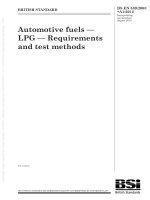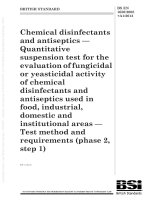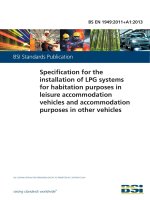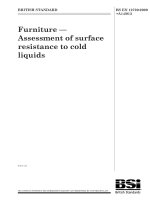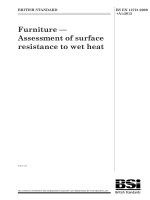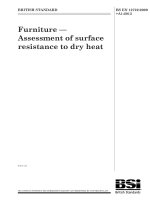Bsi bs en 01400 2013 + a1 2014
Bạn đang xem bản rút gọn của tài liệu. Xem và tải ngay bản đầy đủ của tài liệu tại đây (3.97 MB, 90 trang )
BS EN 140B0S:2E0N131+4A001:20143
BSI Standards Publication
Child use and care articles —
Soothers for babies and young
children — Safety requirements
and test methods
BS EN 1400:2013+A1:2014 BRITISH STANDARD
National foreword
This British Standard is the UK implementation of EN 1400:2013+A1:2014.
It supersedes BS EN 1400:2013 which is withdrawn.
The start and finish of text introduced or altered by amendment is
indicated in the text by tags. Tags indicating changes to CEN text carry
the number of the CEN amendment. For example, text altered by CEN
amendment A1 is indicated by .
The UK participation in its preparation was entrusted by Technical
Committee CW/1, Safety of child use and child care products, to
Subcommittee CW/1/4, Feeding, drinking and mouthing.
A list of organizations represented on this subcommittee can be
obtained on request to its secretary.
This publication does not purport to include all the necessary provisions
of a contract. Users are responsible for its correct application.
© The British Standards Institution 2014.
Published by BSI Standards Limited 2014
ISBN 978 0 580 84086 9
ICS 97.190
Compliance with a British Standard cannot confer immunity from
legal obligations.
This British Standard was published under the authority of the Standards
Policy and Strategy Committee on 30 April 2013.
Amendments/corrigenda issued since publication
Date Text affected
Implementation of CEN amendment A1:2014
EUROPEAN STANDARD EN 1400:2013+A1
NORME EUROPÉENNE
EUROPÄISCHE NORM April 2014
ICS 97.190 Supersedes EN 1400:2013
English Version
Child use and care articles - Soothers for babies and young
children - Safety requirements and test methods
Articles de puériculture - Sucettes pour nourrissons et Artikel für Säuglinge und Kleinkinder - Schnuller für
jeunes enfants - Exigences de sécurité et méthodes d'essai Säuglinge und Kleinkinder - Sicherheitstechnische
Anforderungen und Prüfverfahren
This European Standard was approved by CEN on 12 January 2013 and includes Amendment 1 approved by CEN on 25 February 2014.
CEN members are bound to comply with the CEN/CENELEC Internal Regulations which stipulate the conditions for giving this European
Standard the status of a national standard without any alteration. Up-to-date lists and bibliographical references concerning such national
standards may be obtained on application to the CEN-CENELEC Management Centre or to any CEN member.
This European Standard exists in three official versions (English, French, German). A version in any other language made by translation
under the responsibility of a CEN member into its own language and notified to the CEN-CENELEC Management Centre has the same
status as the official versions.
CEN members are the national standards bodies of Austria, Belgium, Bulgaria, Croatia, Cyprus, Czech Republic, Denmark, Estonia,
Finland, Former Yugoslav Republic of Macedonia, France, Germany, Greece, Hungary, Iceland, Ireland, Italy, Latvia, Lithuania,
Luxembourg, Malta, Netherlands, Norway, Poland, Portugal, Romania, Slovakia, Slovenia, Spain, Sweden, Switzerland, Turkey and United
Kingdom.
EUROPEAN COMMITTEE FOR STANDARDIZATION
COMITÉ EUROPÉEN DE NORMALISATION
EUROPÄISCHES KOMITEE FÜR NORMUNG
CEN-CENELEC Management Centre: Avenue Marnix 17, B-1000 Brussels
© 2014 CEN All rights of exploitation in any form and by any means reserved Ref. No. EN 1400:2013+A1:2014 E
worldwide for CEN national Members.
BS EN 1400:2013+A1:2014
EN 1400:2013+A1:2014 (E)
Contents Page
Foreword ..............................................................................................................................................................3
Introduction .........................................................................................................................................................4
1 Scope ......................................................................................................................................................5
2 Normative references ............................................................................................................................5
3 Terms and definitions ...........................................................................................................................5
4 Description of a soother .......................................................................................................................7
5 Test equipment ................................................................................................................................... 11
6 General................................................................................................................................................. 18
7 Printing and decals............................................................................................................................. 21
8 Construction properties and tests .................................................................................................... 21
9 Mechanical properties ........................................................................................................................ 35
10 Chemical requirements and test methods ....................................................................................... 43
11 Teat protectors.................................................................................................................................... 51
12 Consumer packaging ......................................................................................................................... 53
13 Product information............................................................................................................................ 53
14 Test report ........................................................................................................................................... 55
Annex A (normative) Warnings....................................................................................................................... 57
Annex B (informative) Rationale ..................................................................................................................... 61
Annex C (informative) Information for products resembling a soother ..................................................... 72
Annex D (informative) Some examples of suitable fixing devices .............................................................. 74
Annex E (informative) Soothers — Assessment of compliance with standard — Sampling plan
and compliance levels for freshly manufactured samples ............................................................ 77
Annex F (informative) A suitable HPLC apparatus and method for determination of 2-
Mercaptobenzothiazole (MBT) and antioxidants BHT, 2246, Cyanox 425, Wingstay L and
Irganox 1520 ........................................................................................................................................ 79
Annex G (informative) Graphical representation for determining puncture resistance of a teat ............ 83
Annex H (informative) A–deviations............................................................................................................... 84
Bibliography ..................................................................................................................................................... 85
2
BS EN 1400:2013+A1:2014
EN 1400:2013+A1:2014 (E)
Foreword
This document (EN 1400:2013+A1:2014) has been prepared by Technical Committee CEN/TC 252 “Child use
and care articles”, the secretariat of which is held by AFNOR.
This European Standard shall be given the status of a national standard, either by publication of an identical
text or by endorsement, at the latest by October 2014, and conflicting national standards shall be withdrawn at
the latest by October 2014.
Attention is drawn to the possibility that some of the elements of this document may be the subject of patent
rights. CEN [and/or CENELEC] shall not be held responsible for identifying any or all such patent rights.
This document includes Amendment 1 approved by CEN on 25 February 2014.
This document supersedes !EN 1400:2013".
The start and finish of text introduced or altered by amendment is indicated in the text by tags !".
This document has been prepared under a mandate (M/264) given to CEN by the European Commission and
the European Free Trade Association.
This standard is linked to the General Product Safety Directive (GPSD) but no Annex ZA is needed because
GPSD is not a New Approach Directive and does not include Essential Requirements to which such an annex
should refer.
The most significant change from EN 1400:2002 is that the three parts of that standard have been combined
into one single document.
In addition, improvements to several of the testing equipment have been made, including the shield template
and probes for ventilation holes and finger traps.
A number of common migration rules have been adopted as has the concept of allocating only a proportion of
TDI's when setting migration limits.
For the first time, requirements have been set for teat protectors as has supply chain information for products
that contain vulcanised rubber.
According to the CEN-CENELEC Internal Regulations, the national standards organizations of the following
countries are bound to implement this European Standard: Austria, Belgium, Bulgaria, Croatia, Cyprus, Czech
Republic, Denmark, Estonia, Finland, Former Yugoslav Republic of Macedonia, France, Germany, Greece,
Hungary, Iceland, Ireland, Italy, Latvia, Lithuania, Luxembourg, Malta, Netherlands, Norway, Poland, Portugal,
Romania, Slovakia, Slovenia, Spain, Sweden, Switzerland, Turkey and the United Kingdom.
3
BS EN 1400:2013+A1:2014
EN 1400:2013+A1:2014 (E)
Introduction
Soothers are widely used throughout Europe to satisfy non-nutritive sucking needs and to pacify children.
They are designed to be in the mouths of babies and young children for long periods. Accidents, some of
which have been fatal, have occurred in the past and a prime purpose of this standard is to reduce the risk of
accidents occurring in the future. It is stressed that this European Standard cannot eliminate all possible risks
to babies and young children using such a product and that parental or guardian control is of paramount
importance. It is essential that all warnings and instructions specified in this standard are given clearly by the
manufacturer, to allow the consumer to ensure that the soother is used correctly and safely.
This European Standard harmonises minimum safety requirements and test methods for soothers. Most of the
provisions have been taken from other existing national and European Standards.
It is recommended that manufacturers and suppliers operate to EN ISO 9001, the standard for quality
management systems [1]. It is also recommended that laboratories operate to ISO/IEC 17025, General
requirements for the competence of testing and calibration laboratories [4].
In addition, it is recognised that some organisations require reference testing. A suggested sampling plan and
compliance levels for freshly manufactured soothers are provided in Annex E (informative). This procedure
can be used as a voluntary type approval procedure.
Latex protein allergy risk has not been included in this standard. Nevertheless, provision for packaging
information for soothers containing natural rubber has been made in this standard. There is no published
information that sensitisation is caused by soother teats. In addition, there is an extremely low incidence of
latex protein allergy among young children and babies. However, the issue of subsequent allergic reaction
from rubber teats will be reconsidered when further information becomes available.
Phthalates have not been included in this standard because the use of phthalates in childcare articles is
restricted by Annex XVII of REACH Regulation [5].
A normative annex has been included which contains translations of warning phrases into the main European
languages.
4
BS EN 1400:2013+A1:2014
EN 1400:2013+A1:2014 (E)
1 Scope
This European Standard specifies safety requirements relating to the materials, construction, performance,
packaging and product information for soothers.
This European Standard is applicable to products that resemble or function as a soother. Some soothers may
be marketed with other functions. This standard is applicable to these products (some examples are given in
Annex C).
This European Standard does not apply to products designed for specialist clinical medical applications, e.g.
those relating to Pierre-Robin Syndrome or premature babies (see Annex C).
The standard is not applicable to feeding teats. Safety requirements and test methods for feeding teats are
included in all parts of EN 14350 [2], [3].
2 Normative references
The following documents, in whole or in part, are normatively referenced in this document and are
indispensable for its application. For dated references, only the edition cited applies. For undated references,
the latest edition of the referenced document (including any amendments) applies.
DIN 53160-1, Determination of the colourfastness of articles for common use — Part 1: Test with artificial
saliva
EN 71-1, Safety of toys — Part 1: Mechanical and physical properties
EN 71-3, Safety of toys — Part 3: Migration of certain elements
EN 71-11:2005, Safety of toys — Part 11: Organic chemical compounds — Methods of analysis
EN 12868, Child use and care articles — Methods for determining the release of N-Nitrosamines and N-
Nitrosatable substances from elastomer or rubber teats and soothers
EN 20105-A03, Textiles — Tests for colour fastness — Part A03: Grey scale for assessing staining (ISO 105-
A03)
EN ISO 1302, Geometrical Product Specifications (GPS) — Indication of surface texture in technical product
documentation (ISO 1302)
EN ISO 3696, Water for analytical laboratory use — Specification and test methods (ISO 3696)
ISO 188, Rubber, vulcanized or thermoplastic — Accelerated ageing or heat resistance tests
3 Terms and definitions
For the purposes of this document, the following terms and definitions apply.
3.1
soother
article which includes a teat and which is intended to satisfy the non-nutritive sucking need of children
Note 1 to entry: Soothers are also known as pacifiers or babies' dummies.
3.2
teat
part of the soother designed to be placed in the mouth
5
BS EN 1400:2013+A1:2014
EN 1400:2013+A1:2014 (E)
3.3
shield
structure positioned at the rear of the teat to reduce the likelihood of the soother being drawn entirely into the
child's mouth
3.4
ring
structure positioned adjacent to or on the shield to facilitate handling of the soother
Note 1 to entry: The ring, knob or cover can be integral with the shield or plug or it can be a separate component that is
attached to the shield or plug
Note 2 to entry: See Figure 1.
3.5
knob
structure positioned adjacent to or on the shield to facilitate gripping of the soother
Note 1 to entry: The ring, knob or cover can be integral with the shield or plug or it can be a separate component that is
attached to the shield or plug.
Note 2 to entry: See Figure 2.
3.6
plug
device located within the neck of the teat that secures the teat to the shield
Note 1 to entry: See Figure 3.
3.7
cover
device that prevents open access to the plug
Note 1 to entry: The ring, knob or cover can be integral with the shield or plug or it can be a separate component that is
attached to the shield or plug.
Note 2 to entry: See Figure 3.
3.8
ventilation hole (see B.7)
any shape of hole in the shield or teat protector that is large enough to allow sufficient passage of air to
sustain life
Note 1 to entry: See also 8.4.1 and 11.3.1.
3.9
teat protector
device that can be attached to and detached from the soother to cover the teat
3.10
outer packaging
any packaging used for storage of the product by a retailer, not including the packaging intended for the
consumer
3.11
major axis of the soother
major axis of the soother goes at right angles to the shield and through the centre of the teat, where the teat
enters the shield
6
BS EN 1400:2013+A1:2014
EN 1400:2013+A1:2014 (E)
Note 1 to entry: See Figure 14.
3.12
major axis of the shield
major axis of the shield is parallel to the longest dimension of the shield and in the middle of the width
Note 1 to entry: See Figure 15.
4 Description of a soother
A soother, as shown in Figures 1, 2, 3 and 4, normally consists of:
— a teat,
— a shield, and
— either a ring or knob,
and can include:
— a plug, and
— a cover.
NOTE 1 Similar components are marked with the same number in Figures 1 to 4.
NOTE 2 Some or all of the components may be manufactured from the same material which may result in the
components not being separately distinguishable.
NOTE 3 The ring, knob or cover can be integral with the shield or plug or it can be a separate component that is
attached to the shield or plug.
7
BS EN 1400:2013+A1:2014
EN 1400:2013+A1:2014 (E)
Key
1 teat
2 shield
3 ring
5 cover
7 sucking face of shield
8 rear face of shield
Figure 1 — Example of a soother with ring
8
BS EN 1400:2013+A1:2014
EN 1400:2013+A1:2014 (E)
Key
1 teat
2 shield
4 plug
6 knob
Figure 2 — Example of a soother with knob
9
BS EN 1400:2013+A1:2014
EN 1400:2013+A1:2014 (E)
Key
1 teat
2 shield
4 plug
5 cover
6 knob
7 sucking face of shield
8 rear face of shield
Figure 3 — Example of a soother with plug and cover
10
BS EN 1400:2013+A1:2014
EN 1400:2013+A1:2014 (E)
Key
1 teat
2 shield
4 plug
6 knob
Figure 4 — Example of a soother with a combined plug and knob
5 Test equipment
5.1 Shield template
The shield template shall be made from Polyoxymethylene (POM), standard (natural, non pigmented, unfilled),
E-modulus: 3000 MPa to 3300 MPa, hardness: 80 to 90 Shore D, Surface roughness: lower than Ra 2,2.
NOTE Extruded sheets of POM normally meet the surface roughness requirement.
The dimensions shall be as shown in Figure 5.
11
BS EN 1400:2013+A1:2014
EN 1400:2013+A1:2014 (E)
Dimensions in millimetres
Key
1 enlarged part section A – A
2 permanent marks for major and minor axes
Figure 5 — Shield template
5.2 Test spheres
Test spheres A, B, C and D, shall be made from stainless steel of diameters given in Table 1.
12
BS EN 1400:2013+A1:2014
EN 1400:2013+A1:2014 (E)
Table 1 — Test sphere diameters
Test sphere Diameter
A mm
4,0−0 +0,1
B 5,5+0 −0,1
C 12−0 +0,1
D 14−0 +0,1
5.3 Indentor
The indentor is made from H13 high chrome tool steel or equivalent and hardened to a minimum of
50 Rockwell C and shall have dimensions as shown in Figure 6. All dimensions with a tolerance are machined
as in EN ISO 1302 to Ra 0,4 .The larger diameter of the indentor has not been specified, as it should be of a
size to fit into the equipment for applying the necessary force specified in the test methods.
Dimensions in millimetres
Key
a This face is flat and has dimensions of (3,0 x 0,20) mm.
Figure 6 — Indentor
5.4 Cutting board
The cutting board is made from a polymeric material of (70 ± 5) Shore D hardness with a stop made from any
suitable material to the dimensions as shown in Figure 7. All dimensions shall have a tolerance of ± 2 mm
except where indicated. A centre line and point of puncture is to be marked onto the surface as shown in
Figure 7.
13
BS EN 1400:2013+A1:2014
EN 1400:2013+A1:2014 (E)
Dimensions in millimetres
Key
1 stop for cut edge of teat
2 position of teat
3 point of puncture
Figure 7 — Cutting board
5.5 Bite endurance jaws
The jaws are made from H13 high chrome tool steel or equivalent and hardened to (45 to 50) Rockwell C and
shall have dimensions as shown in Figure 8.
All dimensions with a tolerance are machined as in EN ISO 1302 to Ra 0,4 . All dimensions for the top and
bottom jaws are identical.
14
BS EN 1400:2013+A1:2014
EN 1400:2013+A1:2014 (E)
Dimensions in millimetres
Figure 8 — Bite endurance jaws
5.6 Impact mass
A flat stainless steel weight with radiused edges (2 ± 0,5) mm and a mass of (1 ± 0,02) kg, distributed over an
area of diameter (80 ± 2) mm, see Figure 9.
Dimensions in millimetres
Key
a radius (2 ± 0,5) mm
Figure 9 — Impact mass
15
BS EN 1400:2013+A1:2014
EN 1400:2013+A1:2014 (E)
5.7 Guides
Guides 1, 2 and 3 with dimensions as shown in Figures 10, 11 and 12.
Dimensions in millimetres
Figure 10 — Guide 1
16
BS EN 1400:2013+A1:2014
EN 1400:2013+A1:2014 (E)
Dimensions in millimetres
Figure 11 — Guide 2
17
BS EN 1400:2013+A1:2014
EN 1400:2013+A1:2014 (E)
Dimensions in millimetres
Figure 12 — Guide 3
6 General
6.1 Tolerances for construction and mechanical properties
Unless otherwise stated, the following tolerances apply:
— forces: ± 5 % of the nominal force;
— masses: ± 0,5 % of the nominal mass;
— dimensions: ±1,0 mm of the nominal dimension;
— angles: ± 2º of the nominal angle;
— duration of forces for durability tests: ± 1 s;
— duration of forces for static load tests: ± 2 s.
18
